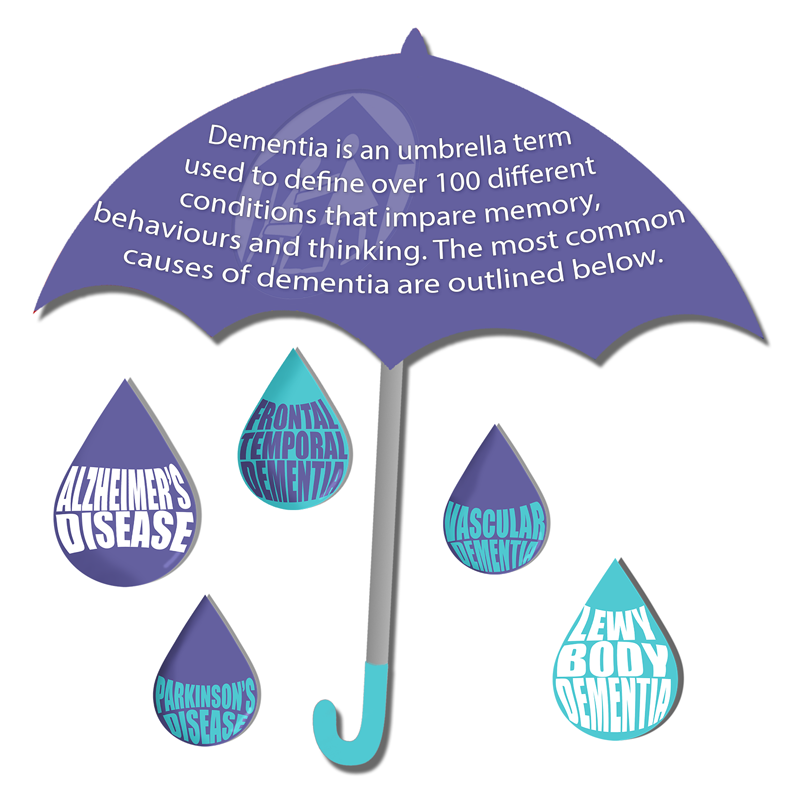About Alzheimer’s Disease
Alzheimer’s usually starts in the hippocampus, the part of the brain essential in forming memories. As more neurons die, the disease gradually spreads to other parts of the brain.
Alzheimer’s is named after Dr. Alois Alzheimer, a German physician, who in 1906, described changes in the brain tissue of a woman who had died of what was thought to be an unusual illness. He found abnormal clumps (now called amyloid plaques) and tangled bundles of fibers (now called neurofibrillary tangles). These plaques and tangles are now considered the hallmarks of Alzheimer’s disease.
Alzheimer’s usually starts in the hippocampus, the part of the brain essential in forming memories and as more neurons die, gradually spreads to other parts of the brain. Although treatment may temporarily delay the appearance of symptoms in some people with Alzheimer’s, currently there is no medication that cures this devastating disease.
Dementia vs Normal Aging
Dementia is an umbrella term used to describe over 100 different conditions that impair memory, behavior and thinking. Alzheimer’s disease is the most common form of dementia. While people who are aging normally may forget things as well, they will typically remember them later.

Watch our short animation to learn about the early warning signs for Alzheimer’s:
Early warning signs include:
What Causes Alzheimer’s?
Scientists don’t yet fully understand what causes Alzheimer’s disease in most people. In people with early-onset Alzheimer’s, a genetic mutation is usually the cause. Late-onset Alzheimer’s arises from a complex series of brain changes that occur over decades. The causes probably include a combination of genetic, environmental, and lifestyle factors. The importance of any one of these factors in increasing or decreasing the risk of developing Alzheimer’s may differ from person to person.
The Basics of Alzheimer’s
Scientists are conducting studies to learn more about plaques, tangles, and other biological features of Alzheimer’s disease. Advances in brain imaging techniques allow researchers to see the development and spread of abnormal amyloid and tau proteins in the living brain, as well as changes in brain structure and function. Scientists are also exploring the very earliest steps in the disease process by studying changes in the brain and body fluids that can be detected years before Alzheimer’s symptoms appear. Findings from these studies will help in understanding the causes of Alzheimer’s and make diagnosis easier.
One of the great mysteries of Alzheimer’s disease is why it largely strikes older adults. Research on normal brain aging is shedding light on this question. For example, scientists are learning how age-related changes in the brain may harm neurons and contribute to Alzheimer’s damage. These age-related changes include atrophy (shrinking) of certain parts of the brain, inflammation, production of unstable molecules called free radicals, and mitochondrial dysfunction (a breakdown of energy production within a cell).
Genetics
Most people with Alzheimer’s have the late-onset form of the disease, in which symptoms become apparent in their mid-60s. The apolipoprotein E (APOE) gene is involved in late-onset Alzheimer’s. This gene has several forms. One of them, APOE ε4, increases a person’s risk of developing the disease and is also associated with an earlier age of disease onset. However, carrying the APOE ε4 form of the gene does not mean that a person will definitely develop Alzheimer’s disease, and some people with no APOE ε4 may also develop the disease.
Also, scientists have identified a number of regions of interest in the genome (an organism’s complete set of DNA) that may increase a person’s risk for late-onset Alzheimer’s to varying degrees.
Early-onset Alzheimer’s occurs between a person’s 30s to mid-60s and represents less than 10 percent of all people with Alzheimer’s. Some cases are caused by an inherited change in one of three genes, resulting in a type known as early-onset familial Alzheimer’s disease, or FAD. For other cases of early-onset Alzheimer’s, research suggests there may be a genetic component related to factors other than these three genes.
Health, Environmental, and Lifestyle Factors
Research suggests that a host of factors beyond genetics may play a role in the development and course of Alzheimer’s disease. There is a great deal of interest, for example, in the relationship between cognitive decline and vascular conditions such as heart disease, stroke, and high blood pressure, as well as metabolic conditions such as diabetes and obesity. Ongoing research will help us understand whether and how reducing risk factors for these conditions may also reduce the risk of Alzheimer’s.
A nutritious diet, physical activity, social engagement, and mentally stimulating pursuits have all been associated with helping people stay healthy as they age. These factors might also help reduce the risk of cognitive decline and Alzheimer’s disease. Clinical trials are testing some of these possibilities.
Concerned about memory loss or other symptoms? Call us and let us answer your questions at 888.280.6055

